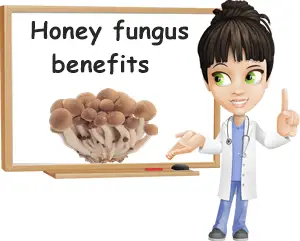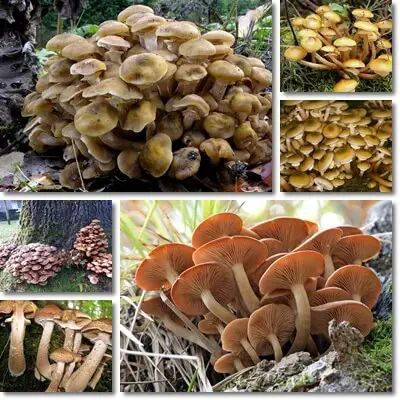Honey fungus is a species of wild mushroom that requires cooking to make it safe for consumption. It goes by the scientific name Armillaria mellea and can be found throughout Europe, Asia, Canada and North America. It is a prolific and highly resilient parasitic, but also edible species. Other common names include the honey mushroom, evocative of the amber or brownish yellow color of the mushroom cap, or the stump mushroom, suggestive of its parasitic nature, colonizing the base of trees, infiltrating their root system and bark to feed and spread, all while causing root rot. In Italy, where it is extremely popular, it’s known as ‘fungo chiodino’ (plural: ‘funghi chiodini’).
What does honey fungus look like? The overall appearance of honey fungi, Armillaria mellea, is that of a crowded cluster of yellowish-brown or brownish-colored mushrooms growing at the base of trees and around them. Adult specimens have a typical mushroom appearance: a smooth umbrella-shaped cap supported by a tall stipe or stalk. The cap is yellowish-brown (or amber) or brownish in color, hence the common names ‘honey fungus’ and ‘honey mushroom’.

Sometimes, the cap becomes darker-colored in the middle and scaly. Inside, it’s white. At maturity, it can reach about 15 cm in diameter. The gills underneath the cap are usually yellowish-brown or slightly pinkish. The upper part of the stalk is creamy white, while the lower part a brownish-yellow. In adult mushrooms, the stalk can reach 20 cm in length. There may or may not be a ring around the stalk; if present, it’s often creamy white and velvety. All the mushrooms in a cluster are actually connected at the base with each other, hence the clumpy appearance. The size of honey fungi varies with age.
Honey fungus look-alikes. Armillaria mellea identification can be difficult as there are both similar-looking, related, but edible species and inedible or poisonous look-alikes. In addition to other Armillaria species, mushrooms in the Pholiota genus can easily be mistaken for A. mellea. Pholiota communis is fairly similar in appearance, but orange-brown in color, with a sticky surface. Pholiota iterata is also fairly similar-looking, but the cap is pale yellow in color with a dull brown center and a sticky surface. Both species grow in clusters, similar to A. mellea. A. mellea can also be confused with poisonous species in the Galerina genus.
Unless you are a seasoned forager and know exactly how to tell similar-looking species apart, it’s best to avoid eating mushrooms picked from the wild. Instead, get them from the supermarket, a mushroom farm in your area, any place that offers some form of assurance or certification of the product and its edibility.
What does honey fungus taste like? Armillaria mellea has a typical mushroom taste: mildly nutty, with light sweet flavors and a faint sweet smell. There are also bitter and/or acidic flavor notes which are seen as indicators of mild toxicity. The texture can be described as slightly chewy, meaty even, and the mushroom remains firm even after being well-cooked. Honey fungi should only be eaten after being parboiled, then thoroughly cooked. The water used for parboiling/pre-cooking should be discarded.

Nutrition and health benefits
Armillaria mellea nutrition. There is little research available on the nutritional profile of honey fungus. For the most part, the nutritional facts attributed to the species are inferred from knowledge of the nutrition of mushrooms in general (such as a good vitamin D2 content). However, studies performed on Armillaria mellea honey fungus specimens from Romania show the following values for various microelements: copper (15.8 mg/kg), iron (221 mg/kg), zinc (77.3 mg/kg). The same study also revealed the presence of selenium. Another study on A. mellea mushrooms sourced from Romanian forests revealed a high content of both iron and chromium. Calcium, magnesium, manganese, phosphorus, potassium and sodium were also identified in the mushroom cap and stipe or stalk.
Source 1: “Metal content and crude polysaccharide characterization of selected mushrooms growing in Romania”. By Zavastin, Daniela Elena; Biliută, Gabriela; Dodi, Gianina; Macsim, Ana-Maria; Lisa, Gabriela; Gherman, Simona Petronela; Breabăn, Iuliana Gabriela; Miron, Anca; Coseri, Sergiu. Published in Subtropical plant science 2018 v.67 pp. 149-158.
Source 2: “Elemental profile of edible mushrooms from a forest near a major Romanian city”. Zsigmond, Andreea R.; Varga, Krisztina; Harangi, Sándor; Baranyai, Edina; Urák, István. Published in Acta Universitatis Sapientiae. Agriculture and environment 2015 v.7 no.1 pp. 98-107.
Armillaria mellea health benefits. The following health effects are possible as a result of a reasonable consumption of honey fungus as part of an overall healthy, varied and balanced diet:
1) More regular bowel movements and constipation prevention and relief from dietary fiber.
2) Healthier gut flora and an increase in the number and diversity of lactic acid bacteria.
3) Good food for weight loss thanks to its low energetic value (low calorie content).
4) Source of vitamin D2 with benefits for immunity, fertility, bone health and mental health.
5) Source of iron – helps boost vitality and combat fatigue.
6) Varied mineral profile – contributes to meeting nutritional demands.
7) Source of vitamin D, calcium, magnesium, phosphorus – promotes strong bones and teeth.
8) Compounds in the honey fungus have been found to improve insulin sensitivity.
9) Exhibits anti-inflammatory activity and exhibits antioxidant and anticancer properties.
A water-soluble polysaccharide in the honey fungus Armillaria mellea has immune system boosting properties (stimulates the proliferation of lymphocytes) and exhibits antitumor properties (inhibits the progression of a line of lung cancer cells and increases apoptosis). Armillarikin, another compound isolated from the mushroom species, has been found to induce apoptosis in 3 different human leukemia cell lines.
Side effects and contraindications
1) Armillaria mellea edibility. The edibility of honey fungus mushrooms is questioned. Some experts consider the species edible, but others classify it as conditionally-edible and warn about its potential for side effects. There are voices that recommend honey fungi be eaten only cooked, after being parboiled to remove potentially toxic compounds such as melleolides which have cytotoxic properties.
In addition to honey fungi requiring cooking prior to consumption to render them safe for eating, it’s sometimes advised to avoid mushrooms growing on certain trees such as some horse chestnut species or locust trees or even eucalyptus. The explanation is that the mushrooms may concentrate potentially harmful amounts of certain compounds with toxic properties since they feed off the trees.
2) Source of heavy metals. All mushrooms accumulate heavy metals from the surrounding environment and honey fungi too have the ability to do so. Which makes it important to source them from pristine areas to avoid heavy metal contamination and subsequent side effects. Avoid collecting mushrooms growing by roadsides or in the vicinity of industrial areas or big cities.
3) Gastrointestinal upset. Side effects such as gastrointestinal upset with symptoms such as abdominal cramps, nausea, vomiting sensation, loose stools or diarrhea have been reported. It is contraindicated to associate some Armillaria species with alcohol. The potential for gastrointestinal upset is also the reason why it’s recommended to parboil honey fungi. Still, some people may experience indigestion symptoms following consumption.
Honey fungus facts
1) The honey fungus is presently identified by its scientific name as Armillaria mellea, but up to 10 related varieties were called by the same name.
2) The mushrooms can grow on living trees or decaying wood material.
3) The mushroom is considered mildly toxic when eaten raw, but not poisonous.
4) The species is classified as both an edible mushroom and a long-living tree parasite, the source of Armillaria root rot or white root rot.
5) The fungal infection can easily survive for up to 50 years in the soil and affect newly planted trees.
6) The infection spreads in white, fuzzy layers underneath the tree bark. The mushroom grows black, string-like fibrous root structures as it moves underground to advance its colonization of trees.
7) The honey fungus species has the ability to glow. The light-producing part is the mycellium, the thread-like filamentous roots that branch out underground and help the mushroom feed and grow.
